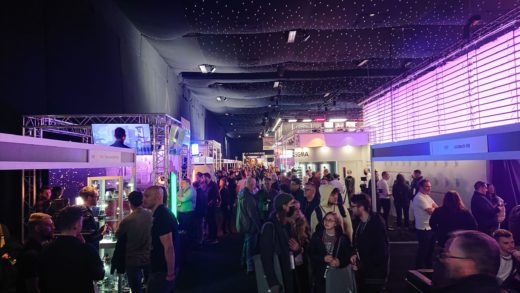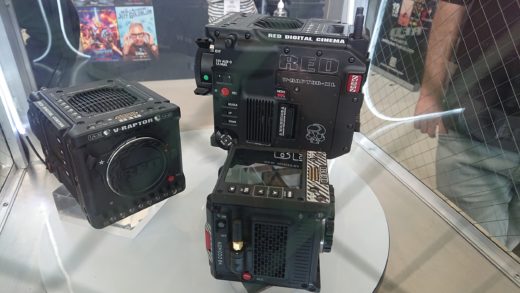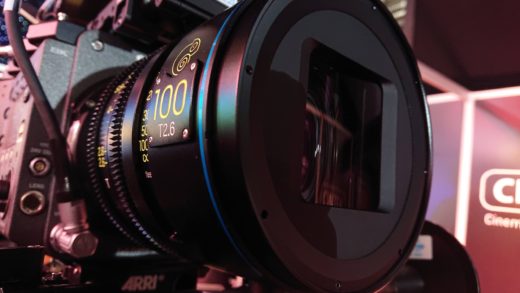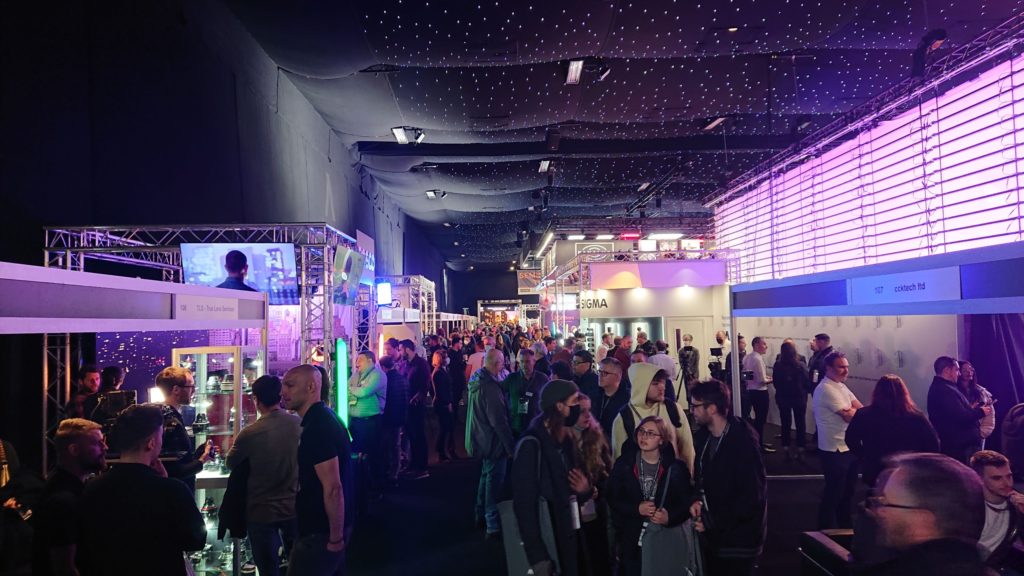
Given recent history, probably one of the most remarkable things about the 2022 BSC Expo is that there was a 2022 BSC Expo. Held from April 7-9 at the Evolution exhibition centre at Battersea in London, the show more usually takes place in late January, meaning it was both the last pre-pandemic show and is the first post-pandemic show for a large proportion of both exhibitors and attendees.
So, having risen from the post-outing bath of sanitising gel like a recently-enhanced superhero, let’s consider what there was to see. Positioned appropriately near the entrance, Red was eager to give its new V-Raptor XL camera its first ever public outing, albeit from behind wired glass intended to prevent either theft or escape.
The camera is bulkier than the original V-Raptor and several times the volume of something like a Komodo, alongside which it sat. Still, it’s still only the size of a device other companies would refer to as “mini” and packs in a lot of accessories that might otherwise bulk out studio configurations. It’s clearly the answer to something like the full-fat Alexa LF in terms of building more things into the body, but it’s hard to ignore the fact that the V-Raptor XL is probably only a bit more than half the size of Arri’s aircraft-carrier of a flagship.

Squishyvision reigns supreme
Something that utterly failed to separate Red from the pack, however, was the tendency to put extremely expensive full-frame anamorphics on all its full-frame demo cameras. A straw poll of exhibitors might have suggested that three-quarters of all the lenses ever made have been anamorphics of some sort. While that may not be true globally, it was true at BSC Expo, from the widely-adored Cooke S7/i to the less common, but very well-specified, Caldwell Chameleon over at Cintek’s booth. With interchangeable rear elements to suit both conventional and large format sensors, the Chameleons offer a 1.79:1 squeeze and a call-for-pricing market position.
Just a few paces away, British lens supremos True Lens Services’ modest side-of-the-hall booth belies the company’s success. What’s unusual is that TLS is now selling new-build lenses; previously, lucky punters would be required to turn up with an existing set to be rehoused. The TLS Vega series goes from 20 to 135mm and achieves T1.5 from 24 to 104. It’s based, the company says, on modern Canon stills glass in much the way the famed K35s were based on stills lenses of their era.

Thus, Vega is a rehousing, but not one aimed at capturing the character (coin in the swear box) of old glass. Instead, they’re presumably likely to offer the sort of scintillating razor-sharpness, high contrast and details for which modern stills designs are famed, and of which modern movie cameras are more than capable of taking advantage. Giant screens beckon. So does mild diffusion. To step briefly away from the technology, consider a problem faced by TLS as well as the rest of the film industry, and which came up several times in different contexts at the show: the issue of finding qualified staff. Waiting lists on TLS rehousing work reportedly exceed a year.
Even once the gear makes it to a rental house, much less on set, the shortage of warm bodies continues. It’s a concomitant, clearly, of the production boom provoked by a coincidence of peak streaming media and a post-pandemic backlog, but the shortage of people has perhaps been building for longer than that. We’ll spare the company the inconvenience of being named, but one major, internationally-recognised exhibitor complained of staff shortages and then went on to admit that it had no formal, and not even much of an informal, apprenticeship program.
That’s not great.
Plight of new entrants addressed
To an extent this is puts rental facilities in an invidious position. They’re widely seen as an entry point and a stepping stone to on-set work and can find themselves spending effort training people who don’t stick around. Regardless, the industry needs training opportunities for new people that doesn’t involve eighteen months of making tea with nebulous hints of maybe a job offer at the end of it. That seems to have been recognised by London post production and digital lab facility Digital Orchard, which ran a talent bar at which new entrants or steppers-up could meet with experienced people from all over the industry. Still a little nebulous, perhaps, compared to a career in, say, medicine or the military, but a recognition of a problem that everyone else seems perpetually too busy to take any responsibility for solving. Hats off, then, to Digital Orchard and its crucial initiative.
It’s a problem that’s traditionally discussed on the shuttle bus from Sloane Square tube station to the Battersea venue, not least because it’s often full of people who were looking for ways not to pay for an Uber – that is, film students (and the odd journalist). Most noticeable, though, was the fact that the bus was in fact fairly full, and the show floor was very full. It bodes well for the upcoming NAB and Cine Gear conferences, but perhaps less well for long-term infection rates, given the decidedly intermittent adherence to mask protocol. There’s a concerning mismatch between the understandable desire of people to detach themselves from two years of spiders’ webs and their unwillingness to mask up. Still, with UK infection rates just barely beginning to slide in the right direction, and at least a desire to go to trade shows, here’s hoping Vegas and LA do as well as the BSC Expo just has.

Filmtools
Filmmakers go-to destination for pre-production, production & post production equipment!
Shop Now













